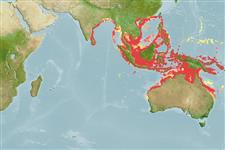>
Eupercaria/misc (Various families in series Eupercaria) >
Lutjanidae (Snappers) > Lutjaninae
Etymology: Lutjanus: Malay, ikan lutjan, name of a fish.
More on author: Richardson.
Environment: milieu / climate zone / distribuzione batimetrica / distribution range
Ecologia
marino associati a barriera corallina; distribuzione batimetrica 1 - 80 m (Ref. 9710). Tropical; 23°N - 27°S, 79°E - 159°E (Ref. 55)
Indo-West Pacific: India to northern Australia. Sometimes referred to as Lutjanus chrysotaenia by past authors.
Length at first maturity / Size / Peso / Age
Maturità: Lm 18.6 range ? - ? cm
Max length : 40.0 cm TL maschio/sesso non determinato; (Ref. 55); common length : 30.0 cm TL maschio/sesso non determinato; (Ref. 55); Età massima riportata: 20 anni (Ref. 37970)
Spine dorsali (totale) : 10; Raggi dorsali molli (totale) : 14 - 16; Spine anali: 3; Raggi anali molli: 9. Snout somewhat pointed, dorsal profile of head steeply sloped. Preorbital bone about equal to eye diameter, or slightly wider. Preopercular notch and knob poorly developed. Scale rows on back rising obliquely above lateral line. Generally blue-gray on upper side, grading to white or yellow white ventrally with a series of eight or nine or orange or yellow stripes on the sides. The fins are yellowish; the pectoral fins have a distinct black spot at base of uppermost rays and axil.
Body shape (shape guide): fusiform / normal; Cross section: oval.
May be found in turbid coastal waters (Ref. 90102). Adults inhabit coral reefs in both sheltered lagoons and on outer reef slopes. Often encountered in schools of up to 20 to 30 individuals. (Ref. 55)
Multiple spawner.
Allen, G.R., 1985. FAO Species Catalogue. Vol. 6. Snappers of the world. An annotated and illustrated catalogue of lutjanid species known to date. FAO Fish. Synop. 125(6):208 p. Rome: FAO. (Ref. 55)
IUCN Red List Status (Ref. 130435: Version 2025-1)
Threat to humans
Harmless
Human uses
Pesca: scarso interesse commerciale; Pesce da pesca sportiva: si
Strumenti
Special reports
Download XML
Fonti Internet
Estimates based on models
Preferred temperature (Fonte Biblio.
123201): 25.1 - 29.1, mean 28.2 °C (based on 1340 cells).
Phylogenetic diversity index (Fonte Biblio.
82804): PD
50 = 0.5000 [Uniqueness, from 0.5 = low to 2.0 = high].
Bayesian length-weight: a=0.01479 (0.00745 - 0.02937), b=2.96 (2.80 - 3.12), in cm total length, based on LWR estimates for this species & Genus-body shape (Ref.
93245).
Trophic level (Fonte Biblio.
69278): 3.9 ±0.5 se; based on diet studies.
Resilienza (Fonte Biblio.
120179): Medio, tempo minimo di raddoppiamento della popolazione 1.4 - 4.4 anni (K=0.37-0.45; tmax=20; Fec > 10,000).
Fishing Vulnerability (Ref.
59153): Low to moderate vulnerability (26 of 100).
🛈
Nutrients (Ref.
124155): Calcium = 39.8 [23.9, 60.7] mg/100g; Iron = 0.392 [0.255, 0.642] mg/100g; Protein = 18.3 [16.8, 19.6] %; Omega3 = 0.138 [0.093, 0.205] g/100g; Selenium = 59.3 [35.5, 99.9] μg/100g; VitaminA = 224 [44, 920] μg/100g; Zinc = 0.433 [0.332, 0.617] mg/100g (wet weight);
